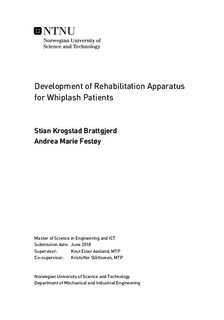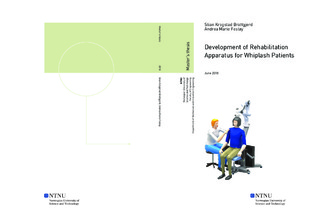| dc.contributor.advisor | Aasland, Knut Einar | |
| dc.contributor.advisor | Slåttsveen, Kristoffer | |
| dc.contributor.author | Brattgjerd, Stian Krogstad | |
| dc.contributor.author | Festøy, Andrea Marie | |
| dc.date.accessioned | 2018-09-05T14:01:39Z | |
| dc.date.available | 2018-09-05T14:01:39Z | |
| dc.date.created | 2018-06-08 | |
| dc.date.issued | 2018 | |
| dc.identifier | ntnudaim:18435 | |
| dc.identifier.uri | http://hdl.handle.net/11250/2561051 | |
| dc.description.abstract | Firda Physical Medicine Center (FPMC) specializes in diagnosis and rehabilitation of neck injuries. Today FPMC conducts part of their rehabilitation training through an apparatus called the Multi-Cervical Unit (MCU). The MCU is an apparatus that restricts the patient to rotate his/her head in only one plane, while producing resistance against the movement, thus training their neck muscles. However, FPMC is not pleased with the MCU. The MCU is old fashioned, and as an example only allows rotation in three directions. A partnership between FPMC and NTNU was established with the intent of developing a new training apparatus. Numerous designs and prototypes have been developed in previous projects. The latest project recommended investigating a design where a robotic arm is used to provide resistance. The project recommended the use of the robotic arm Panda from Franka Emika due to its attractive price and advanced sensor technology.
The scope of this master's thesis was to continue the development by a feasibility study of using the robotic arm Panda to provide resistance. The robot's workspace and load capacity were to be tested and incorporated into an apparatus. The robot arm would need to be placed on a rigid surface (frame structure) which would provide a suitable position relative to the patient's head. In addition, a suitable tool allowing the patient's head to be fixed to the robot (head mount) was needed. The head mount would have to fit different head sizes and create comfort for the user. This master thesis aimed to accomplish both simulations of the robotic arm Panda and to build a proof of concept prototype of the frame structure and head mount.
The load capacity and workspace of Panda were simulated using a computer model. The simulations showed that Panda failed to deliver the specified training space as it could not deliver full backward bending with the current base position of the robot. When executing backward bending the robotic arm is retracted to the extent that it collides with itself. The simulations showed that the load capacity of Panda is adequate. The proof of concept prototype was realized, including the frame structure and head mount. The head mount was constructed from an alpine helmet and inflatable inserts. It seems to be a good solution since it fits different head types and acts as a strong enough fixing point to handle the forces related to the resistance.
Recommendations for next stage in the development are to evaluate if Panda can deliver the training space with modifications of the base position. Feedback from patients on the proof of concept prototype should be collected to decide on further design and development. A compromise between training space, cost and size may be unavoidable. | |
| dc.language | eng | |
| dc.publisher | NTNU | |
| dc.subject | Produktutvikling og produksjon, Produktutvikling og materialer | |
| dc.subject | Ingeniørvitenskap og IKT, IKT, produktutvikling og materialer | |
| dc.title | Development of Rehabilitation Apparatus for Whiplash Patients | |
| dc.type | Master thesis | |

